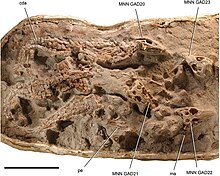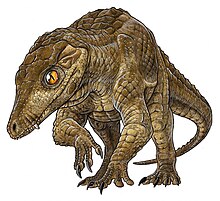阿拉利坡鳄
| 阿拉利坡鳄属 化石时期:
| |
|---|---|

| |
| 阿拉利坡鳄的想像图 | |
| 科学分类 | |
| 界: | 动物界 Animalia |
| 门: | 脊索动物门 Chordata |
| 纲: | 爬行纲 Reptilia |
| 科: | †乌拉圭鳄科 Uruguaysuchidae |
| 属: | †阿拉利坡鳄属 Araripesuchus Price, 1959 |
| 种 | |
| |
阿拉利坡鳄(学名:Araripesuchus)是种史前鳄鱼,化石发现于南美洲与非洲,年代为白垩纪中到晚期(阿普第阶到马斯特里赫特阶),约1亿2500万到6500万年前[1][2]。古生物学家根据其颅骨、牙齿型态,将阿拉利坡鳄归类于中真鳄类的诺托鳄类[3]。根据估计,阿拉利坡鳄的身长约1到1.8米,体重约40公斤[4]。阿拉利坡鳄的两颊突出,前上颌骨各有一颗较大的牙齿。[5]阿拉利坡鳄目前已有五个有效属。
发现历史
[编辑]
阿拉利坡鳄是在1959年叙述、命名,模式种是A. gomesii。阿拉利坡鳄的正模标本(编号DNPM 423-R)是一个颅骨、部分下颌,发现于巴西的桑塔那组(Santana Formation),年代为白垩纪中期。当地还出土另一个较完整的标本(编号AMNH 24450)[3]。在1981年,法国古生物学家E. Buffetaut将出土于非洲尼日的标本(编号GDF-700),建立为第二个种,A. wegeneri。这个标本包含下颌的零碎骨头,年代属于白垩纪早期[1]。在2000年,其他古生物学家根据发现于阿根廷巴塔哥尼亚的标本(编号MUC-PV 269),建立第三个种A. patagonicus,年代是白垩纪晚期[6]。在2005年,第四个种A. buitreraensis被建立,标本(编号MPCA-PV 235)是一个颅骨,长度为13公分,发现于阿根廷的巴塔哥尼亚地区,年代也属于白垩纪晚期;这标本也是已知最大型的阿拉利坡鳄标本[5]。隔年,一个发现于马达加斯加的标本被建立为第五个种A. tsangatsangana,年代为白垩纪最后一期,是已知生存年派最晚的阿拉利坡鳄[2]。
分类学
[编辑]阿拉利坡鳄目前已有六个有效种,包含:模式种A. gomesii[3]、A. wegeneri[1]、A. patagonicus[6]、A. buitreraensis[5]、A. tsangatsangana[2]、A. rattoides[7]。
其中,发现于尼日的A. wegeneri曾被许多科学家质疑其有效性,被建议需要建立为新属[6]。直到马达加斯加的A. tsangatsangana被发现,这两个非洲的种才被接纳为有效种。在同份研究里,其他种也被承认是有效种[2]。
在1959年,阿拉利坡鳄最初被归类于乌拉圭鳄科(Uruguaysuchidae)。在1981年,E. Buffetaut仍维持同一分类法[1]。但是在2000年,其他科学家在建立第三个种时,仅提出乌拉圭鳄可能是阿拉利坡鳄的近亲,并没有将阿拉利坡鳄归类于特定科[6]。
在2000年,F. J. Ortega等人提出阿拉利坡鳄不属于诺托鳄类。在某些种系发生学研究,阿拉利坡鳄被归类成新鳄类的近亲;新鳄类后来演化出现代鳄鱼。在近年的分类研究里,阿拉利坡鳄被分类成诺托鳄类的基础物种。在2011年,M. Soto将阿拉利坡鳄重新归类到乌拉圭鳄科,并将乌拉圭鳄科归类于诺托鳄类的最基础物种[8]。

以下来自于2011年的乌拉圭鳄研究:
| 诺托鳄类 |
| |||||||||||||||||||||||||||||||||||||||||||||||||||||||||||||||||||||||||||||||||||||||||||||
古生态学
[编辑]
阿拉利坡鳄的化石来自于南美洲、非洲、马达加斯加,显示该物种起源于南方的冈瓦那大陆[1]。当阿拉利坡鳄出现时,南美洲、非洲、马达加斯加已经彼此分离,显示牠们在冈瓦那大陆分裂前就已发生演化辐射[2]。
参考资料
[编辑]- ^ 1.0 1.1 1.2 1.3 1.4 Buffetaut, E. Die biogeographische Geschichte der Krokodilier, mit Beschreibung einer neuen Art, Araripesuchus wegeneri. Geologische Rundschau. 1981, 70 (2): 611–624. doi:10.1007/BF01822139.
- ^ 2.0 2.1 2.2 2.3 2.4 Turner, A. H. Osteology and phylogeny of a new species of Araripesuchus (Crocodyliformes: Mesoeucrocodylia) from the Late Cretaceous of Madagascar. Historical Biology. 2006, 18 (3): 255–369. doi:10.1080/08912960500516112.
- ^ 3.0 3.1 3.2 (葡萄牙文)Price, L. I. Sobre um crocodilideo notossuquio do Cretacico Brasileiro. Boletim Divisao de Geolgia e Mineralogia Rio de Janeiro (Brazil). 1959, 118: 1–55.
- ^ 存档副本. [2012-06-22]. (原始内容存档于2020-10-31).
- ^ 5.0 5.1 5.2 Pol, Diego; Sebastian Apesteguia. New Araripesuchus Remains from the Early Late Cretaceous (Cenomanian–Turonian) or Patagonia. American Museum Novitates (American Museum of Natural History). October 2005, 3490 (1): 1–38 [2008-12-27]. ISSN 0003-0082. doi:10.1206/0003-0082(2005)490[0001:NARFTE]2.0.CO;2. (原始内容存档于2014-12-07).
- ^ 6.0 6.1 6.2 6.3 Ortega, F. J.; Z. B. Gasparini, A. D. Buscalioni and J. O. Calvo. A new species of Araripesuchus (Crocodylomorpha, Mesoeucrocodylia) from the Lower Cretaceous of Patagonia (Argentina). Journal of Vertebrate Paleontology. 2000, 20 (1): 57–76. doi:10.1671/0272-4634(2000)020[0057:ANSOAC]2.0.CO;2.
- ^ Sereno, P.C.; Larsson, H.C.E. Cretaceous Crocodyliforms from the Sahara. ZooKeys. 2009, 28: 1–143 [2012-04-11]. doi:10.3897/zookeys.28.325. (原始内容存档于2011-01-09).
- ^ Soto, M.; Pol, D.; and Perea, D. A new specimen of Uruguaysuchus aznarezi (Crocodyliformes: Notosuchia) from the middle Cretaceous of Uruguay and its phylogenetic relationships. Zoological Journal of the Linnean Society. 2011, 163 (S1): S173–S198 [2012-04-11]. doi:10.1111/j.1096-3642.2011.00717.x. (原始内容存档于2016-03-04).
| ||||||||||||||||||||||||||||||||||||||||||||||||||||||||||||||||||||||||||||||||||||||||||||||||||||||||||||||||||||||||||||||||||||||||||||||||||||||||||||||||||
|
Text is available under the CC BY-SA 4.0 license; additional terms may apply.
Images, videos and audio are available under their respective licenses.

